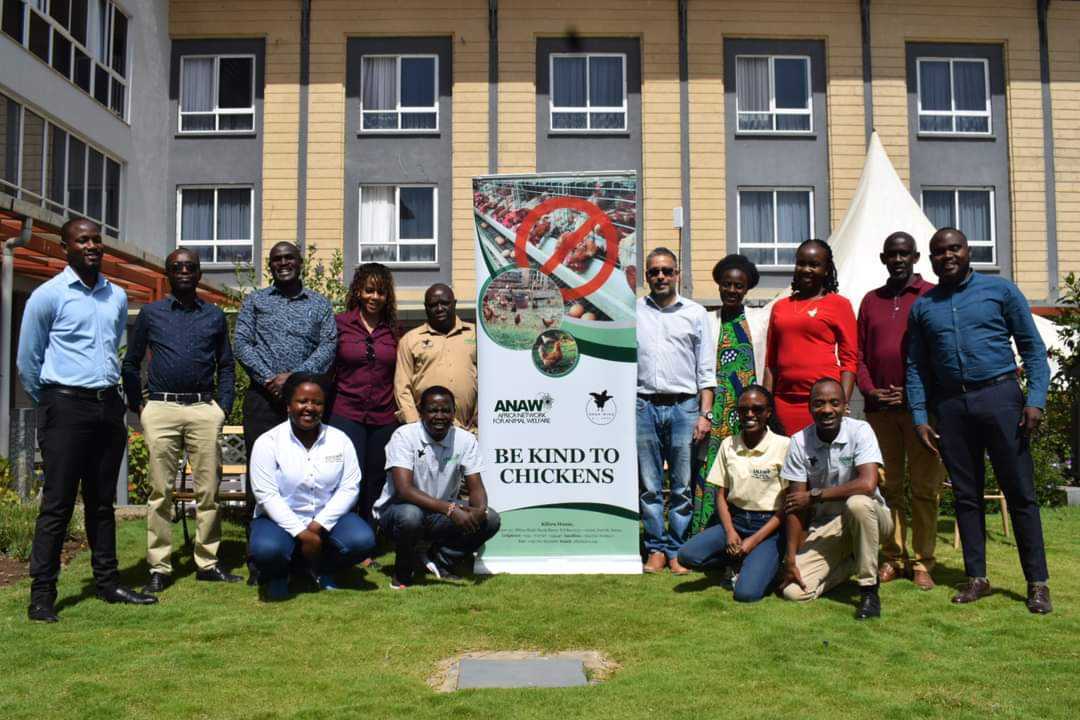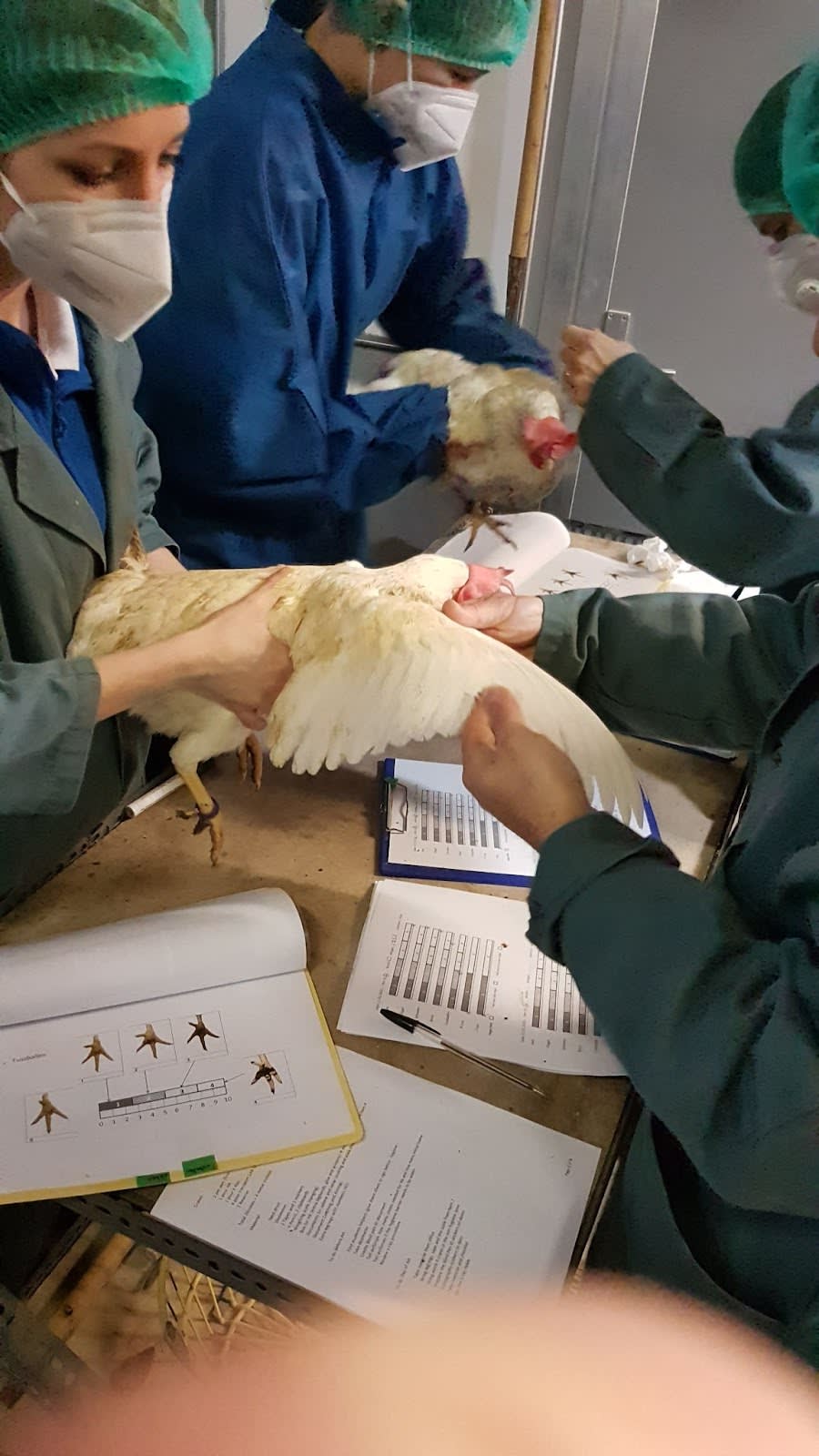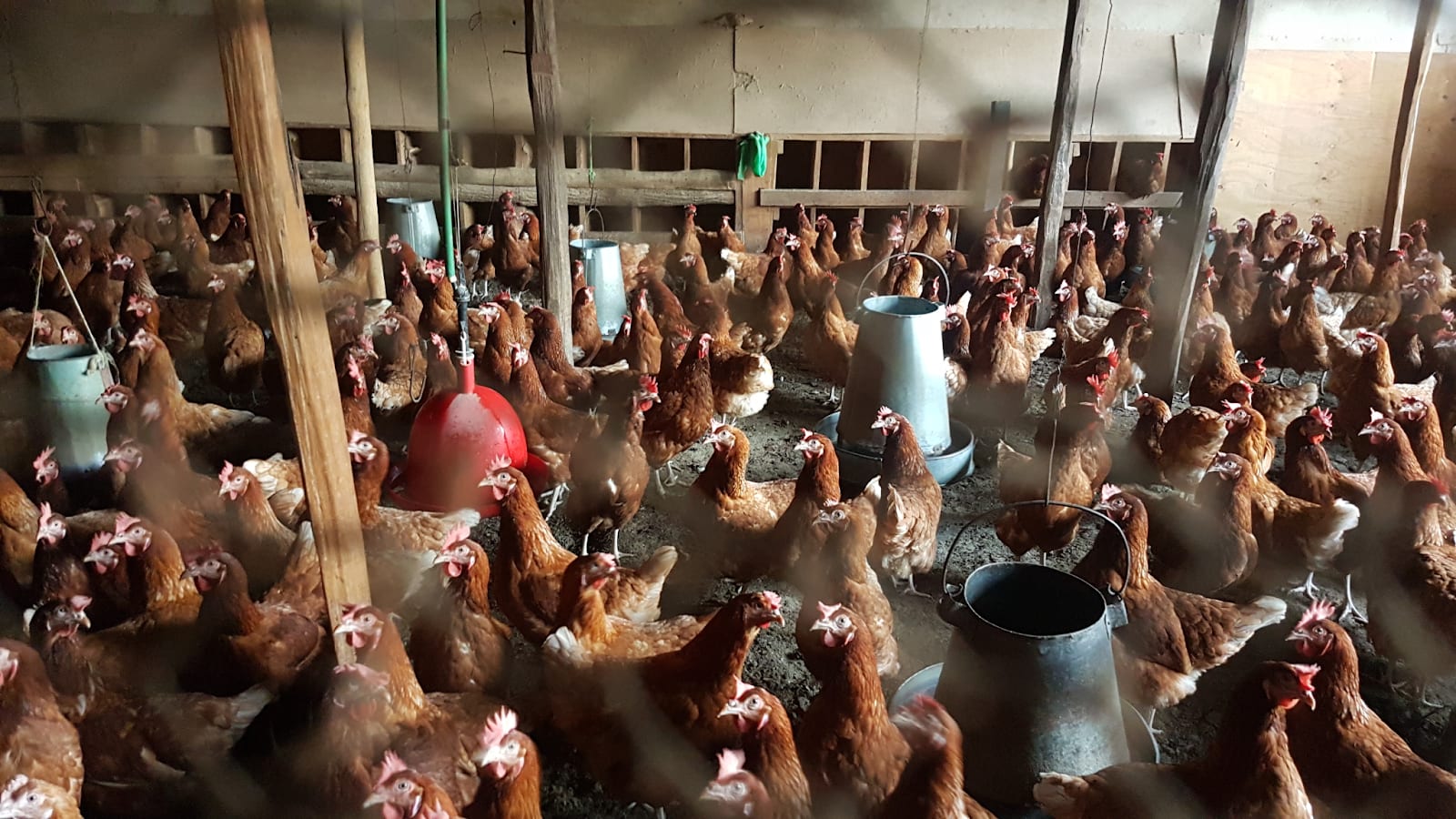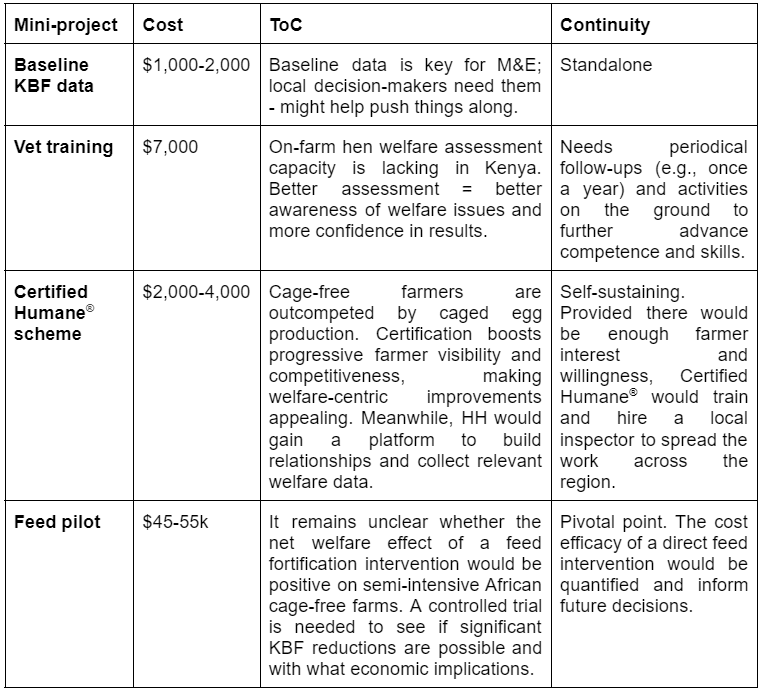TL;DR
Healthier Hens (HH) has scaled down due to not being able to secure enough funding to provide a sufficient runway to pilot dietary interventions effectively. We will continue through mini-projects and refining our plan for a feed pilot on the ground until our next organisational assessment at the end of summer 2023. Most efforts will now be spent on reporting, dissemination and fundraising. In this post we share updates, show what went well, less so and what others can learn from our attempts.
Our mission and updated approach
Keel bone fractures (KBF) are the second biggest source of hens’ suffering after behavioural deprivation related to cages, and the biggest in cage-free systems. Our mission remains to reduce the suffering of hens by addressing this source of pain. Numerous studies indicate that dietary interventions can reduce bone fractures. Our goal is to find ways to help hens get adequate nutrition and experience less pain. Besides research and piloting activities, we are doing that by outreach and collaboration with Kenyan cage-free egg farming stakeholders (including farmers, feed mills, universities and regulators) to improve on-farm hen welfare. Please read our introductory, 6M and 1Y update posts to learn more about the background and progress of HH. Due to funding constraints, we have downscaled and now focus on building capacity through mini-projects before piloting an intervention on the ground.
HH Y1.5 update
- We decided to scale down and as of the first of March 2023, HH is a volunteer-led organisation. We will have our next evaluation point at the end of summer 2023.
- Despite major delays brought on by the presidential elections in Kenya, HH is finally a registered entity in both the US and our country of pilot operations.
- We carried out two additional farmer workshops in Murang’a and Nakuru counties. A report outlining this work will be published in May 2023. The workshops revealed significant knowledge gaps coupled with expressed interest by the farmers to learn and improve. To retain engagement, we began providing free resources and formed a WhatsApp group to stay connected with motivated cage-free farmers.
 Cage-free farmer workshop in Nakuru county, October, 2022. |  Cage-free coalition strategic session in Naivasha in February, 2023. |
- We have published the third volume of our hen feed fortification literature review. This edition focused on nutrient level recommendations and the potential of other additives to improve bone health. We have also published a report outlining our feed sampling findings. It confirms potential issues with Kenyan feed quality and compositional consistency.
- We are engaged in the formation of a regional cage-free coalition aimed at accelerating transition campaigns, led by African Network for Animal Welfare.
- We surveyed our staff in February. We generally felt positive about the organization's culture and values. The survey also reveals that we were generally satisfied with our team and work, but were concerned about the impact of the recent decision to downscale. We also felt that there was a lack of critical feedback and constant communication within the team.
- Our collaboration with the University of Bern indicates negative results of a split-feeding intervention. While we expected a decrease in KBFs without compromising egg quality, surprisingly, poorer egg quality, digestive issues and neutral-to-negative effect on KBFs are observed.
- To explore alternative fundraising avenues, we looked into several social enterprise concepts, where hen welfare benefits could be attained while also improving the livelihoods of African cage-free farmers. The chosen concept (a hybridised adaptation of the work by Global Food Partners, FAI Farms and The One Acre Fund) was submitted to the 100xImpact acceleration programme. We have since learned that the concept did not go through and will reapply in May.
- As a result of the scaledown, we have identified several activities that are promising and potentially feasible with a much smaller budget. These ‘mini-projects’ include getting local KBF data, facilitating hen welfare training for veterinary professionals, and introducing the Certified Humane® certification scheme in the region. Check what we need below, in the funding opportunities section.
 Hen welfare assessment, Switzerland, December 2022. |  Hens at a deep litter cage-free farm, Kenya, 2022. |
HH post downscale assessment
The outcome of downscaling operations provided us with an opportunity to spend more time looking into the initial approach and condense the lessons learned. We hope this section can provide insight into what should be looked out for when doing similar exploratory work.
Did we see this coming?
In retrospect, our pre-mortem discussions including a logframe with threats for achieving impact, organisational risk assessment and contingency planning had a major oversight - funding. We took a careful approach with our activities on the ground with longer-term organisational sustainability in mind. Due to our ability to run relatively lean and the general support within the community we felt overly confident that we will have enough runway to pilot the intervention. This sense of safety prevented us from considering that we might not reach the stage where actual welfare effect sizes/cost-efficacy are the pivotal deciding factors. However, after data analysis, we will be able to, at the very least, make an informed decision regarding a dietary intervention aimed at farms of the Global North, which is being trialled in Switzerland.
Things that went well
Overall, the three organised farmer workshops on hen welfare went well. The farmers were engaged, expressed interest and willingness to learn more and improve their farm management practices. We were able to collect pre- and post-workshop survey data to assess the events’ effect on hen welfare awareness and knowledge. Although there were practical issues related to timing and scheduling, farmer feedback was positive and many participants expressed willingness to collaborate in the future and are open to receiving on-farm training via in-person visits. A full write-up about the workshops and their outcomes is forthcoming.
Our publications also provided much-needed information on the issue of poor-quality feed and the impact nutrition can have on welfare. To date, we have published three volumes of literature review on feed fortification, a feed report outlining the nutrient values of Kenyan feeds, and three in-depth country reports with preliminary feed testing data. As part of our continued outreach to farmers, we have also translated and published several publications from the Brazilian NGO Mira that provide welfare resources to cage-free farmers.
Also, our ability to connect with and glean from experts in the field of hen welfare went really well. There were only a few connections that were not made or were ignored upon repeated attempts to collaborate, but for the most part, we were able to learn from the expertise of many. This also included learning from experts in operations which set us up for success in our hiring processes. We were able to find top candidates for our Country Manager role, as well as have many qualified individuals to choose from for our internships.
Things that didn’t go well
Fundraising. The initial seed funding permitted us to work without putting too much emphasis on fundraising efforts in Y1. In retrospect, we definitely underestimated the organisational risks associated with the possibility of not acquiring enough funding. Through mentorship and supportive feedback loops, we remained too optimistic even after experiencing the first difficulties with fundraising in the second half of Y1. This prompted us to diversify our funding, but we failed to do so effectively. Our fundraising success rate is 28% until now, when considering formal applications to different funders, corresponding to a theoretical total attempted budget of $740k. In total, we made 15 official attempts throughout the course of 1.5 years, an effort that proved to be insufficient. Our original goal was to have $450k for Y1+2 operations. In retrospect, perhaps we should have attempted to raise double the amount to better match our actual success rate. Nevertheless, we found ourselves with no funding to get traction, and not enough traction to help us with fundraising in the end. There were, of course, other external factors (e.g. FTX collapse and reduced novel intervention/region support in the farmed animal welfare space), but we are uncertain to what degree this impacted our org versus our own fundraising shortcomings. One clear area where we could have been more diligent was making sure our runway was healthy and evaluating this more often.
Feed testing. Although we expected it would take some trial and error to determine a reliable and cost-effective service we can use for compositional feed analysis on the ground, erratic issues, such as delays, inconsistent reporting and low confidence in the quality of services provided, kept emerging, forcing us to spend more time searching, relationship building, and ultimately, it reduced the confidence of our scoping results.
Delays. In retrospect, we definitely underestimated the timelines for many processes on the ground. While in-country visits seemed to work when coupled with thorough planning in advance (e.g. workshops, some stakeholder meetings), delays seemed unavoidable and should always be factored in. These were felt most notably via restricted communication flows, where stakeholders and potential collaborators would respond slowly or be hard to get a hold of, and official work (e.g., service provision, organisational establishment) delayed by political processes such as presidential elections, policy propositions and negotiations. Finally, some implementation-oriented decisions made by us also resulted in prolonged processes, e.g., stakeholders requesting regional KBF baseline data or the implications of the revealed poor enforcement of and stakeholder engagement with the existent feed standards.
Survey response collection. The effect of welfare workshops on farmer awareness and knowledge was intended to be measured via pre-, post- and post-post-workshop surveys. It was challenging to elicit responses three months after the workshop, despite having created a community WhatsApp group, where free resources were being shared. In the end, being pressed for time, we ended up carrying out in-call surveys. That enabled collecting a smaller sample of responses. We were also unable to carry out evaluations of on-farm changes.
Split-feeding trial. Despite careful experimental design by experts in the field, surprisingly negative effects on hen health and welfare were discovered in the treatment group. The hens receiving most of their daily calcium in evening feed rations experienced digestion issues that persisted even when more balanced morning-evening feeds were provided. The study was ceased due to the documented negative effect on hens’ health and welfare. Similarly, egg quality had dropped, suggesting high economic losses for the farmers, and therefore tractability of change issues.
Finances
We have raised a bit over $220k in total. These funds were: $100k CE’s seed grant, $90k Animal Welfare Fund, $16,300 from EA Infrastructure Fund, and the remaining amount from individual donors.
Budget overview: For the most part our initial budget fit in line with our actuals. The main changes occurred due to the fact that we did not have a person on the ground to conduct proper initial cost analysis. Most of this was done via online research for our initial budget, and with constraints from search engines, cost-of-living not being representative, and other unpredictable costs they were higher than our planned 10% contingency. Several items, e.g. CM salary and per diems were, on average, three times more expensive in reality. We had to update our budget. Unfortunately, this happened after we received several grants, which ended up not stretching as far. Some key changes that needed to be made were increasing the budget for a Country Manager, research activities, and program supplies. Due to these changes, we needed to reduce our budget elsewhere and the main hit came to our in-person country visits both in length and frequency of visits. After this preliminary setback, we were able to stay on track and oftentimes came below budget during monthly checkpoints, due to the contingency we had in place. As our funds dwindled, we expected more to come through, but found it difficult to fundraise for continued high operational support and for specific projects that did not hit the scope of some of the funders (geographical focus, limited traction, ability to scale, unorthodox approach). This made us constantly have to push back research and program activities that allowed us to stay operational, but resulted in lean research/program efforts.
How much did we spend on what?
| HQ Personnel | $82,442 |
| Other Personnel Cost | $45,555 |
| Services | $330 |
| Research | $40,000 |
| Program Supplies | $5,425 |
| Outreach | $2,147 |
| Travel | $25,751 |
| Office | $362 |
| Miscellaneous | $4,467 |
| Equipment and Supplies | $1,888 |
| PPF fiscal sponsorship (Y1) | $13,111 |
| Total | $221,478 |
Funding gap for 2023. We aim to raise $55-70k to cover the needs of the mini-projects and a feed pilot. Ideally, we would also manage to raise extra for operations, ensuring that a higher FTE can be allocated.
What would we do differently?
Please revisit the following two EA Forum posts highlighting some key lessons learned from initial pilot country visits and hiring for a new EA-aligned organization in a new country. In general, delays occurred more frequently than expected and there were significant sector-specific changes (e.g. the war in Ukraine increasing feed industry stakeholder reluctance to innovate and a leading caged hen farmer becoming the president of the country) that made work on the ground more challenging. All in all, it would seem that most of it came down to country selection rather than, for example, just having one person on the ground. That being said, we would still prioritise having a larger local team to streamline processes that are under our control.
We have also found that relationships with key stakeholders can be powerful enablers for progress on the ground. Networking activities should be prioritised and constitute a significant fraction of an ambitious project’s work. Despite being integral stakeholders, the farmers struggle to have their voices heard due to a highly fragmented market, an issue that might be leveraged to raise more attention to low-quality and inconsistent feeds.
We also underestimated the need for continental data on the issue. Despite their well-documented and widespread nature, hen bone health issues remain a largely unheard-of topic in Kenya. Many stakeholders we communicate with argue for the importance of having Afrocentric data - not only for knowledge’s sake but also as leverage for advancing discussions with relevant decision-makers on the ground and building more animal science capacity in the region. While an important baseline metric for us, it seems that starting to gather such data could have some indirect effects on the state of affairs in the region.
Invitation for feedback. Since we are reevaluating internally, we would like to invite EA community members to provide us with feedback, concerns or suggestions anonymously. If this is not the first time you hear about HH and what we have been up to, please consider filling this short form and help us make better decisions. Thanks!
More transferables for EAA orgs
We administered an anonymous lessons-learned questionnaire internally that had 20 open-ended questions over four categories: organisation, team, role and other. We will highlight general insights and key suggestions for each category, but you can see the full answers here.
- Organisation: the most positive aspect of working for HH included the opportunity to improve hen welfare, work with a strong team, travel opportunities, and the ability to strategize with experts. The most challenging were delays on the ground, the intervention being too new/restrictive for both funding and stakeholder engagement, and working remotely. To help with that fact, we would recommend having more frequent 1-to-1 and all team meetings with staff, and increasing residency time in the country of operations. We would also recommend to potential international orgs that you should have a local team with diverse skill sets, register the organisation ASAP and seek permits/approvals to avoid delays and understand the true cost of living. Staff also felt that by providing access to conferences, professional development training, and promoting initiative, they were able to succeed and grow. Although, being mostly remote did prevent the addition of individuals who could not feasibly make that work.
- Team: we found that having similar life values, clear and transparent communication, diverse backgrounds and being flexible helped the team work better together. Some aspects that brought about issues or prevented us from excelling were funding struggles, cultural and work differences, working remotely, and depending too much on externalities. We would recommend orgs to further support full-time staff with assistants/interns, identify professional development needs and provide opportunities to improve those skills, as well as learning from each other so everyone can reach their full potential. It is also important to hire a project manager, this was strongly felt as a lacking need from all staff.
- Role: the main takeaway here was the need for additional support and making sure everyone is accountable for their work. If working remotely, or even in-person, making sure you have coworking times so team spirit is felt and responsibilities are shared.
- Other: we additionally asked if there was anything we could have done to stay viable, answers included, “seek funding from and build more partnerships with non-EA organisations” and “perhaps we could have structured our work with clearer milestones along the way that could signify our track record better. Perhaps we could've been more 'vocal' and visible in the community.” We also allowed room for any additional comments and received just one that many new orgs should consider, “Although we might be seen as slow-moving, I am glad we took the careful approach in our work.”.
Policies, templates and examples. Throughout the first years of HH, we developed a number of internal organisation documents and templates for various activities. We realise that developing such structure can take time and that other lean-running EA-aligned organisations or groups might benefit from the examples themselves or our lessons learned while putting them into practice. Feel free to reach out via info@healthierhens.com if you think any of the following would be useful for your work:
|
|
|
|
Funding opportunities
Our scaledown has led to a significantly lower budget as outlined earlier in this post. While the co-founders are able to carry out reporting, dissemination and fundraising activities at no additional compensation, we still see that small steps taken now – the mini-projects, could pave a way for improved hen welfare in Kenya and, perhaps, the region. These do, however, require external funding. In general, we believe that they would yield the best results if carried out sequentially, in combination with each other. However, baseline KBF data collection is one that could have a long-term impact even if carried out standalone. If you believe these activities could benefit hen welfare on African cage-free farms, consider reading our funding proposal and donating or sharing it with other funders. Finally, the overview table below also includes a lean budgeted version of a feed trial that is a six-month project needing significant funding in-full and up-front to ensure its viability. We will apply to larger EA farmed animal welfare grantmakers to acquire the needed funds.

Staying up to date
To stay in the loop with what we’re up to, consider subscribing to our newsletter. Please get in touch if you’d like to comment, criticise our work or suggest something in person. You can meet us at EAG:London, EAGxWarsaw, the European Symposium on Poultry Welfare and CARE Conference. Thank you!
